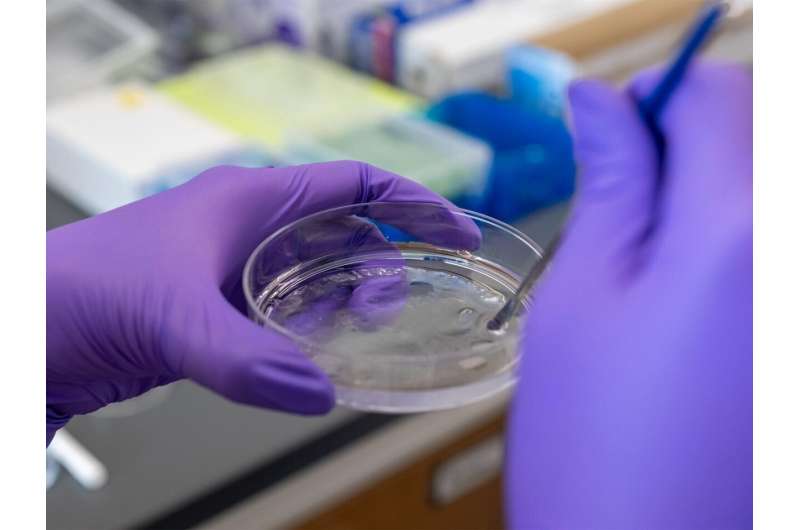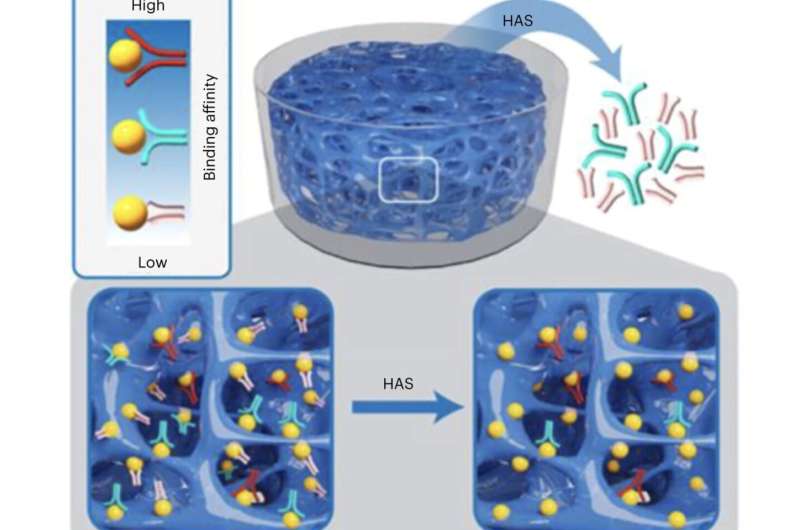This article has been reviewed according to Science X's editorial process and policies. Editors have highlighted the following attributes while ensuring the content's credibility:
fact-checked
peer-reviewed publication
trusted source
proofread
Novel hydrogel finds new aptamers, or 'chemical antibodies,' in days

One double-helix strand of DNA could extend six feet, but it is so tightly coiled that it packs an entire sequence of nucleotides into the tiny nucleus of a cell. If that same DNA was instead split into two strands and divided into many, many short pieces, it would become trillions of uniquely folded 3D molecular structures, capable of bonding to and possibly manipulating specifically shaped molecules—if they're the perfect fit.
These short, single-stranded segments of DNA or RNA are called aptamers, also known as "chemical antibodies." According to Penn State researchers, they are emerging in biomedicine as beneficial therapeutic or diagnostic agents, especially in replacement of biological antibodies. However, finding the perfect aptamer for a target molecule—the p53 protein that suppresses cancerous tumors, for example—requires sifting through a pool of potential aptamer candidates that exceeds the number of stars in the Milky Way galaxy. The process can can take months and often results in no match at all.
A new method developed by Penn State researchers uses a hydrogel—a polymer network that holds its shape and can expand when it takes in a large amount of water—to retain "high-affinity," or well-fitting, aptamers while the rest of the aptamer candidates leave the gel in 60 hours. The team reported their "hydrogel for aptamer selection" (HAS) method and findings in Nature Biotechnology.
The HAS method could lower the barrier for researchers looking to explore the potential for aptamers—which are easier to modify, have a longer shelf life and allow for easier tissue access than antibodies—in a number of biomedical applications, such as regenerative medicine, drug delivery, cell engineering, bioimaging and more, according to corresponding author Yong Wang, professor of biomedical engineering at Penn State.
"The procedure of finding aptamers is frustrating to not only beginners but also experienced researchers—like finding a needle in a haystack," Wang said.
"Many researchers are interested in using aptamers for their projects, but as it is very difficult to get them, they cannot test their ideas or explore novel applications. Aptamers can be used as therapeutics by themselves, they can be conjugated with drugs or nanoparticles to guide delivery and improve efficacy, they can be applied to functionalize a detection kit for examining whether a blood sample contains viruses or cancer biomarkers. Basically, aptamers can be applied anywhere antibodies are designed."
The team's hydrogel—made of polyethylene glycol (PEG)—included immobilized target molecules of the protein thrombin, which helps facilitate clotting in the bloodstream. Once an aptamer library was injected into the hydrogel, high-affinity candidates bonded to the non-moving targets while the less well-fitting aptamers diffused freely through its pores, similarly to how ornaments without hooks would fall through a Christmas tree with nothing to catch on to the branches.
This diffusion approach differs from traditional methods, where target molecules and the aptamer library are mixed in a solution and then filtered through a thin membrane. The filtration step is repeated many times and where good aptamer candidates are often lost, according to Wang.
"Unfortunately, molecular binding is a physical interaction, and during the filtration step, specific candidates can fall apart from target molecules, go through the membrane and get lost," Wang said. "In our method, a desired aptamer candidate will re-bind to an immobilized molecule if it falls apart from a formerly bound target molecule. Therefore, the candidate will not be easily lost during the procedure of diffusion."

The researchers created the porous hydrogel by freezing a pre-gelation solution mixed with acrylic acid, which would later chemically react to carboxyl groups in the polymer to form the embedded thrombin proteins, immobilized so as not to leave the hydrogel.
Ice crystals also appeared during this "cryogelation" process, scattered throughout the PEG polymer network, eventually melting and creating the hydrogel's pores when it was brought to room temperature. PEG is "non-fouling," Wang said, which means the material limits the unwanted bonding of aptamers to the hydrogel, unlike the aptamers' interactions with the membranes.
The HAS method also removes the need for polymerase chain reaction (PCR) amplification, a step in traditional methods where a new aptamer library is synthetically generated every round based on the remaining aptamers in the previous membrane.
"Amplification is based on PCR that has a bias to amplify some candidates instead of treating all candidates equally," Wang said. "Researchers have found that this bias can become more and more severe every time it's repeated, and they may not find what they want after investing a great amount of time, labor and money."
As a baseline test, the researchers developed a PEG hydrogel without the embedded thrombin and introduced the aptamer library, finding there were hardly any remaining aptamers in the gel after 60 hours. This indicated that the "background noise" from non-specific binding—aptamer-to-hydrogel—had dissipated, and it became the time cutoff the researchers used in their testing process.
The aptamer candidates in the thrombin-immobilized hydrogel were collected and analyzed with next-generation sequencing technology. The researchers prioritized 50 aptamer candidates, further categorizing them and testing for binding efficiency. The "anti-thrombin aptamer" identified from the pool was found to have a binding affinity comparable to those identified over 10 cycles of aptamer selection using traditional methods.
"Aptamer selection can be achieved in one single step without the need of a reiterative process, and all concerns with reiterative operations are avoided," said Wang, adding that further work on the HAS method will fine-tune this approach, including selecting aptamers for non-protein target molecules or even living cells if they can be kept in the hydrogel under ambient conditions. "We hope that HAS will help researchers explore various fields that require molecular binding or recognition."
Collaborators on this study also included co-first author Naveen Singh, formerly a postdoctoral researcher in the Penn State Department of Biomedical Engineering, now at the Indian Institute of Technology Delhi; as well as co-first author Yixun Wang, Connie Wen, Brandon Davis, Xuelin Wang and Kyungsene Lee, all Penn State biomedical engineering doctoral students.
More information: Naveen K. Singh et al, High-affinity one-step aptamer selection using a non-fouling porous hydrogel, Nature Biotechnology (2023). DOI: 10.1038/s41587-023-01973-8
Journal information: Nature Biotechnology
Provided by Pennsylvania State University




















